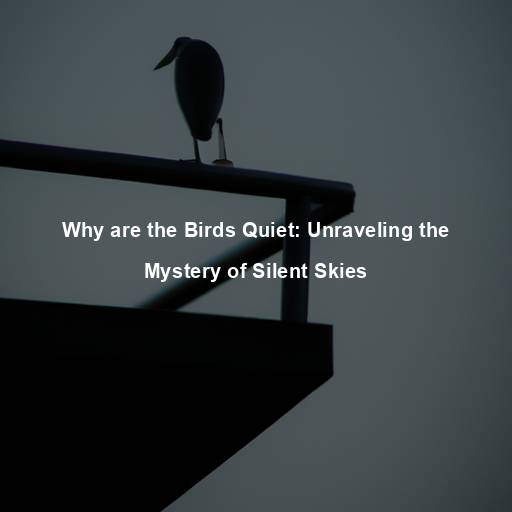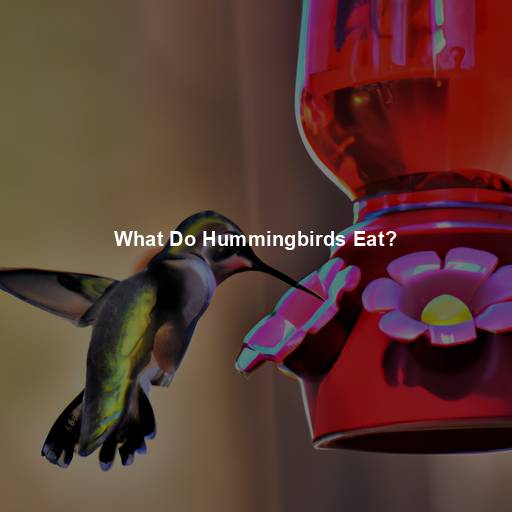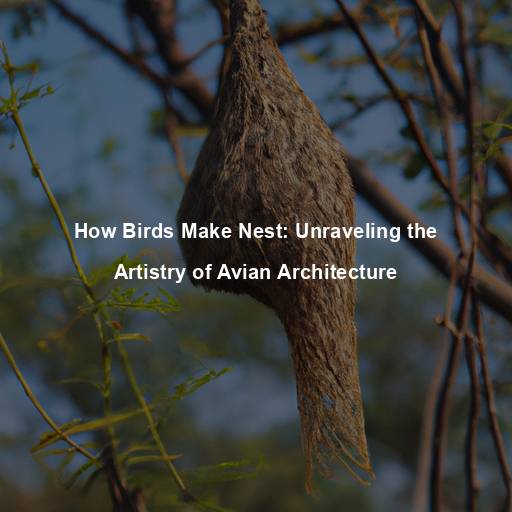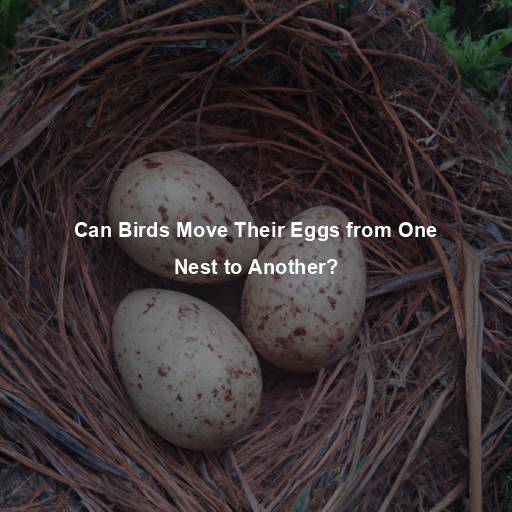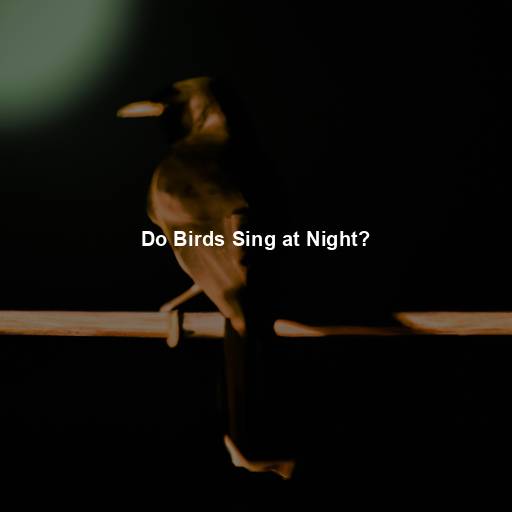Why are the Birds Quiet: Unraveling the Mystery of Silent Skies
Last Updated on November 17, 2023 by Evan
Contents [hide]
- 1 The Intrigue of Silence
- 2 Stay Tuned for More Insights
- 3 The Language of Silence
- 4 Protecting the Voices of the Skies
- 5 Embracing the Mystery
- 6 FAQs: Why Are the Birds Quiet?
- 6.1 Why are the birds not singing as much as usual?
- 6.2 Is there a possibility that the birds have migrated?
- 6.3 Could changes in the environment be affecting the birds’ behavior?
- 6.4 Do birds go quiet during certain times of the day?
- 6.5 Are there specific bird species known for their less vocal behavior?
The Intrigue of Silence
There is something strangely alluring about silence that never fails to draw us in. In a cacophonous world, where noise defines our daily existence, the absence of sound can be simultaneously soothing and unnerving. Among the perplexing enigmas of silence, the stillness of birds stands out as a baffling phenomenon. We are accustomed to their vibrant melodies and cheerful chirping that accompany our days, but what triggers these avian beings to abruptly stifle their symphony?
The Rhythm of Nature
Birdsong is an integral part of the natural world. From dawn till dusk, avian melodies echo through forests, fields, and urban landscapes. This rhythmic chorus not only serves as a means of communication but also plays a vital role in territory establishment, courtship, and warning signals. So, when the usual melody abruptly fades away, it sparks our curiosity.
Seasonal Silence
Birdsong, a symphony of nature, undergoes a transformation as seasons unfold. Spring casts a spell on male birds, whose melodious calls enchant potential mates and proclaim their territorial dominance. With the culmination of the breeding season, a hush descends upon the avian realm. As winter wraps its icy embrace around the landscape, the chorus diminishes, gradually fading to near silence.
The Migratory Retreat
The wondrous phenomenon of migration plays a pivotal role in the curious silencing of our feathered friends. As these intrepid aviators prepare to take flight on their awe-inspiring odysseys, their priorities undergo a captivating transformation. Their melodious tunes, once the soundtrack of their existence, make way for a vital pursuit – gathering strength to endure the forthcoming arduous expedition. Only when they have conquered their wintering or breeding grounds do these resilient creatures reclaim their songs, adorning the atmosphere with their harmonies, staking their claim and announcing their return.
A State of Alert
Birds are incredibly alert creatures, constantly attuned to their surroundings. The presence of predators or other potential threats can induce a state of vigilance, causing them to fall silent. When birds sense danger, they prioritize survival over vocalization. This instinctual response helps them remain hidden from predators, increasing their chances of evading detection.
The Art of Stealth
Some bird species possess exceptional stealth skills, which they employ during their hunting expeditions. These avian predators, such as owls and hawks, rely on surprise to catch their prey. To avoid alerting their quarry, they remain silent as they swoop down from above. The silence of these birds is not a result of a lack of vocal ability but rather a tactical choice that ensures their hunting success.
Human Impact
In a world where concrete jungles stretch endlessly, the intricate dance between our feathered friends and human activities cannot be understated. The bustling symphony of car horns, construction clamor, and our modern existence reverberates through the air, disrupting the melodious tunes birds once sang. In an attempt to adapt to this discordance, our avian companions may find solace in altering their melodious patterns or, in a twist of irony, retreating into a silence that leaves us in awe. This cacophony of noise pollution presents a perplexing challenge for birds, as it threatens their ability to effectively communicate and navigatetheir daily routines, potentially leading to a disturbance in their delicate harmonies of breeding and foraging.
The Language Barrier
Birds possess an incredible repertoire of songs and calls, each serving a specific purpose. However, not all species communicate through vocalizations. Some birds rely on visual displays or non-vocal sounds such as wingbeats, drumming, or bill-clapping to convey messages. Therefore, when we perceive a lack of bird songs, it is essential to remember that silence does not necessarily indicate a lack of communication.
A Symphony Lost?
As we explore the reasons behind the silence of birds, it is crucial to remember that the absence of song does not diminish the beauty and importance of these remarkable creatures. While silence may be perplexing, it is merely a temporary state in the vibrant lives of birds. Whether they are conserving energy, embarking on migratory journeys, remaining vigilant, or employing stealthy hunting tactics, birds continue to enchant us with their grace and resilience. So, the next time you find yourself in the presence of a quiet sky, take a moment to appreciate the mysteries it holds, and let the silent symphony of birds remind you of the wonders of the natural world.
Stay Tuned for More Insights
Step into the mesmerizing world of birds, where every flutter of a wing holds a captivating story waiting to be told. As we immerse ourselves in their realm, brace yourself for the unexpected as we unravel the enigmatic behavior and secrets behind these soaring creatures. From the enchanting melodies of tiny songbirds to the majestic prowess of mighty raptors, our captivating content will transport you into a world where the ordinary becomes extraordinary. So join us on this thrilling journey as we explore the vast expanse of the silent skies, unearthing the mesmerizing wonders of the avian universe.
A Disrupted Balance
Birds around the world find themselves in the crosshairs of an escalating crisis – habitat loss. As our relentless human activities encroach further into their natural homes, these feathered beings are left grappling with the dire consequences. The repercussions are far-reaching: vanishing nesting sites, diminishing foraging spots, and disappearing protective havens. It’s not just the birds that suffer; our intricate ecosystems are thrown into disarray as forests, wetlands, and grasslands are irreparably destroyed.
The Silent Witnesses
When birds find themselves without a place to call home, their options for survival become scarce, leaving them in a state of uncertainty. The loss of their natural habitats forces them to find refuge in urban or fragmented landscapes, which presents its own set of challenges. As they try to adapt to their new surroundings, they are confronted with heightened competition for resources, unfamiliar dangers lurking about, and the constant risk of falling prey to predators. Caught in this perplexing and ever-changing situation, birds often find themselves remaining silent, diligently navigating through their unfamiliar reality in search of safe havens and the elusive establishment of territories.
The Ripple Effect
The damaging aftermath of habitat loss reverberates through more than just the lives of individual bird species. These charismatic creatures, with their wings and melodies, fulfill invaluable roles within the intricate tapestry of ecosystems as conscientious pollinators, diligent seed dispersers, and vigilant regulators of pesky insect populations. Alas, when their numbers dwindle, the delicate interconnectedness of nature is shaken to its core, like a fragile Jenga tower on the brink of collapse. As the harmonious melodies of bird songs fade into an eerie silence, a chilling reminder unfurls before our eyes, pointing to a profound ecological upheaval that extends far beyond the blanket of quiet skies.
The Language of Silence
A Multifaceted Communication System
When we think of bird communication, our minds often gravitate towards the melodic chirps and songs that fill the air. However, there is more to avian interaction than just the auditory aspect. Birds have a fascinating arsenal of non-vocal techniques at their disposal, from captivating visual displays to subtle body language and intriguing non-vocal sounds. These alternative modes of communication, such as wing flapping, courtship dances, bill tapping, and feather displays, offer a glimpse into the complex social interactions that birds engage in.
Silent Signals
Birds have a mysterious and captivating way of communicating beyond just their enchanting songs. Believe it or not, silence can play a crucial role in their intricate social dynamics. Take, for instance, the art of courtship. Male birds, in their quest to woo potential mates, tactfully incorporate strategic pauses within their melodic serenades.
The Unanswered Questions
In the expansive realm of avian exploration, scientists have unearthed remarkable revelations about the intricate language of birds. Yet within this vast expanse of knowledge, myriad enigmas lie in wait to bewilder even the most erudite researchers. A tantalizing riddle within this avian lexicon is the perplexing role of silence, an enigmatic phenomenon that enthralls the scientific community. As these mysteries unfurl beneath the expansive heavens, our comprehension of the intricacies and opulence of the avian domain deepens, serving as a poignant reminder that the uncharted territories of knowledge are ever-enticing for our insatiable curiosity.
Protecting the Voices of the Skies
A Call to Conservation
As we reflect on the reasons behind the quietude of birds, it becomes clear that their silence is not a standalone phenomenon but a reflection of broader ecological challenges. By addressing these challenges, we can help protect the voices of the skies and ensure the survival of bird populations for future generations.
Habitat Conservation
Protecting and rejuvenating habitats lies at the very core of ensuring the vitality of our avian friends. Nurturing these natural havens and forging pathways for wildlife not only grants birds the essential nourishment to flourish, but also safeguards their ancestral abodes. By championing groups dedicated to preserving habitats, actively partaking in local restoration projects, and championing sustainable land management, we can weave a harmonious tapestry that shields and compounds the wellbeing of our feathered companions.
Reducing Human Impact
Noise pollution, light pollution, and other human-induced disturbances disrupt the lives of birds. Taking steps to reduce our impact on the environment can have a positive effect on bird behavior. Using bird-friendly building designs, reducing light pollution, and practicing responsible ecotourism are just a few ways we can minimize our footprint and create a more harmonious coexistence with avian species.
Citizen Science and Monitoring
Engaging in citizen science initiatives and participating in bird monitoring programs can provide valuable data for researchers and conservationists. By contributing our observations and insights, we can help identify population trends, track migration patterns, and gain a deeper understanding of the challenges birds face. This knowledge is crucial for developing effective conservation strategies and ensuring the long-term survival of our feathered friends.
Embracing the Mystery
As we come to the end of our journey into the enigmatic world of hushed skies, one thing becomes abundantly clear: the silence of our feathered companions is far from ordinary. It is a complex confluence of countless variables, ranging from ever-shifting seasons and intricate migratory habits to the intricate dance between man and nature. The moments of tranquil stillness found in the wild urge us to embrace the riddle, to appreciate the remarkable fortitude of these captivating creatures.
As we embark on the endeavor of unraveling the enigma enshrouded within the ethereal expanse of the heavens, let it echo in our minds that each avian species carries within its fragile wings a tale woven with nuances peculiar to its existence. By perceiving and absorbing their harmonious tunes, meticulously studying their behavior, and safeguarding their dwelling grounds, we forge a path where the sweet symphonies of these feathered creatures persist, enchanting our world with their mellifluous melodies. So, let us embark upon this entrancing expedition, with spirits unbarred and minds aflame with an insatiable curiosity, reveling in the captivating splendor and bewildering allure of this extraordinary realm that birds call their own.
FAQs: Why Are the Birds Quiet?
Why are the birds not singing as much as usual?
Birds may be quiet for several reasons. One common explanation is seasonal changes. In certain times of the year, such as during the breeding season or when they molt, birds may reduce their singing activity. This is because they are focused on other important activities like finding a mate, defending their territory, or conserving energy during molt. Another reason could be the presence of predators in the area. If birds perceive an increased danger, they may become more cautious and refrain from singing to avoid attracting attention.
Is there a possibility that the birds have migrated?
Yes, it is possible that the birds have migrated to another location. Many bird species migrate over long distances in search of better food sources, more suitable habitats, or milder climates. During migration, the birds may not be present in their usual areas, resulting in the absence of their songs. However, the exact timing and patterns of bird migration vary depending on the species, so it is essential to consider factors such as the local environment and the specific bird species in question.
Could changes in the environment be affecting the birds’ behavior?
Certainly, changes in the environment can have an impact on bird behavior and vocalizations. Factors such as deforestation, urbanization, pollution, or even extreme weather events can disrupt bird habitats and food availability. If birds are facing a loss of suitable nesting sites or a scarcity of food due to environmental changes, their behavior, including their vocalization patterns, may be influenced. Additionally, certain noises caused by human activities, such as loud construction or industrial sounds, can disturb birds and cause them to reduce their singing.
Do birds go quiet during certain times of the day?
Yes, some birds are more active and vocal during specific times of the day, while they may be quieter during other periods. Many bird species are most active and sing more intensely during the early morning, known as the dawn chorus. This is when birds often defend their territories, attract mates, and search for food. Outside of these peak activity times, birds may be relatively quieter as they rest, conserve energy, or focus on other tasks like foraging or nest maintenance.
Are there specific bird species known for their less vocal behavior?
Birds, fascinating creatures of the sky, have a secret language they use to communicate with each other. However, not all birds are equally chatty. Take, for instance, the enigmatic owls. These mysterious creatures, known for their nighttime activities, prefer to keep their voices hushed during the day, leaving us perplexed about their silence. Likewise, majestic birds of prey like eagles and hawks rely more on their extraordinary vision than their vocal cords, which leaves us pondering the depth of their non-verbal communication skills. Furthermore, some bird species simply prefer simpler songs or occupy habitats where their melodious voices are not as prominent, leaving us marveling at the diversity of avian vocalization. The rhythm and cadence of their voices offer an intriguing glimpse into the enchanting world of our feathered friends.

